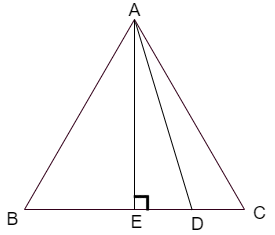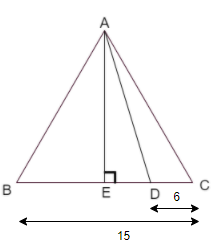
In a triangle
(i)
(ii)
Answer
490.2k+ views
Hint: We solve this problem first by drawing the height from vertex ‘A’ to side ‘BC’. The diagram representing the given data is shown below.

Here the length ‘AE’ will be the height for all the triangles that can be seen in the figure because ‘A’ is a common vertex for all triangles and ‘E’ lies on the base of all triangles. then we use the area formula of triangle given as
By using the above formula we find the required ratios.
Complete step-by-step answer:
We are given that there is a point ‘D’ on ‘BC’ such that
Let us assume that a perpendicular drawn from the vertex ‘A’ to side ‘BC’ as shown in the figure.

Here, we can see that the line ‘AE’ is the height for all three triangles
Now, let us solve for the first part
(i)
We know that the formula for area of triangle is given as
Let us consider the triangle
By using the area formula the area of triangle
Now, let us consider the triangle
By using the area formula the area of triangle
Now, by dividing the equation (i) with equation (ii) we get
By substituting the required values in above equation we get
We know that the ratio definition that is
Therefore, by using the ratio theorem to above equation we get
Now, let us solve for second part
(ii)
We know that the formula for area of triangle is given as
Let us consider the triangle
By using the area formula the area of triangle
Now, let us consider the triangle
By using the area formula the area of triangle
Now, by dividing the equation (i) with equation (iii) we get
Here, we know that the point ‘D’ divides the side ‘BC’ in two parts that is
Now, by substituting the required values in equation (iv) we get
We know that the ratio definition that is
Therefore, by using the ratio theorem to above equation we get
Note: We can solve the second part in another method also.
From the first part we have the ratio
Now by converting ratio to division we get
We know that when a line divides the triangle into two parts then the total area of triangle will be sum of those two parts that is from the figure
By substituting the above equation in equation (v) we get
By converting into ratio we get

Here the length ‘AE’ will be the height for all the triangles that can be seen in the figure because ‘A’ is a common vertex for all triangles and ‘E’ lies on the base of all triangles. then we use the area formula of triangle given as
By using the above formula we find the required ratios.
Complete step-by-step answer:
We are given that there is a point ‘D’ on ‘BC’ such that
Let us assume that a perpendicular drawn from the vertex ‘A’ to side ‘BC’ as shown in the figure.

Here, we can see that the line ‘AE’ is the height for all three triangles
Now, let us solve for the first part
(i)
We know that the formula for area of triangle is given as
Let us consider the triangle
By using the area formula the area of triangle
Now, let us consider the triangle
By using the area formula the area of triangle
Now, by dividing the equation (i) with equation (ii) we get
By substituting the required values in above equation we get
We know that the ratio definition that is
Therefore, by using the ratio theorem to above equation we get
Now, let us solve for second part
(ii)
We know that the formula for area of triangle is given as
Let us consider the triangle
By using the area formula the area of triangle
Now, let us consider the triangle
By using the area formula the area of triangle
Now, by dividing the equation (i) with equation (iii) we get
Here, we know that the point ‘D’ divides the side ‘BC’ in two parts that is
Now, by substituting the required values in equation (iv) we get
We know that the ratio definition that is
Therefore, by using the ratio theorem to above equation we get
Note: We can solve the second part in another method also.
From the first part we have the ratio
Now by converting ratio to division we get
We know that when a line divides the triangle into two parts then the total area of triangle will be sum of those two parts that is from the figure
By substituting the above equation in equation (v) we get
By converting into ratio we get
Recently Updated Pages
Master Class 11 Economics: Engaging Questions & Answers for Success

Master Class 11 Business Studies: Engaging Questions & Answers for Success

Master Class 11 Accountancy: Engaging Questions & Answers for Success

Questions & Answers - Ask your doubts

Master Class 11 Accountancy: Engaging Questions & Answers for Success

Master Class 11 Science: Engaging Questions & Answers for Success

Trending doubts
A boat goes 24 km upstream and 28 km downstream in class 10 maths CBSE

Why is there a time difference of about 5 hours between class 10 social science CBSE

The Equation xxx + 2 is Satisfied when x is Equal to Class 10 Maths

What is the full form of POSCO class 10 social science CBSE

Change the following sentences into negative and interrogative class 10 english CBSE

How do you prove that the diagonals of a rectangle class 10 maths CBSE




